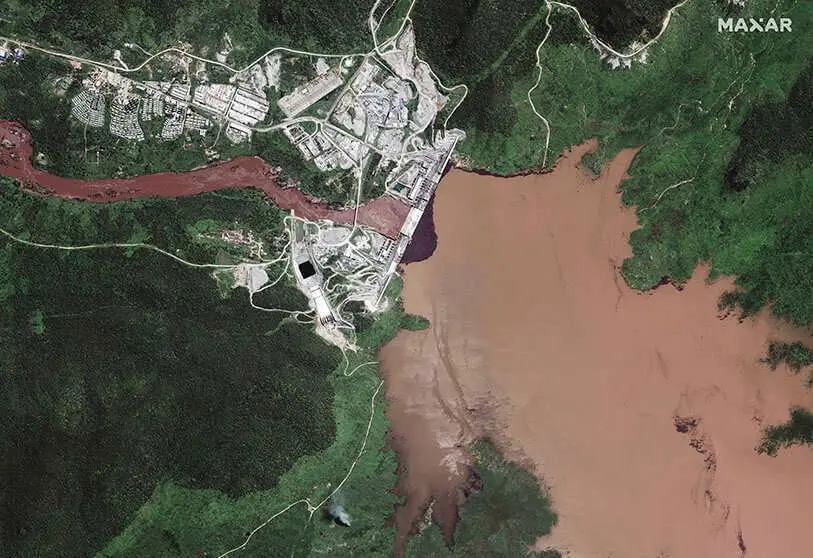The Grand Ethiopian Renaissance Dam threatens relations between Egypt, Ethiopia and Sudan

The transformation of nature by man is and has always been, for thousands of years, an integral part in the creation and subsequent development of some of the states that make up the African continent. The dispute for the control of certain resources - such as water, oil or other raw materials - has led to some of the bloodiest conflicts in recent years. Against this backdrop, and despite having reached no agreement with Egypt or Sudan, Ethiopia began filling its controversial Grand Ethiopian Renaissance Dam (GERD) in the Blue Nile on Wednesday. The Egyptian government was quick to react by demanding "urgent clarification" of reports that Addis Ababa had begun filling the dam, endangering the stability of the region.
The Ethiopian Minister of Water, Irrigation and Energy, Seleshi Bekele, explained through the social network Twitter that the presence of water in the dam was due to the heavy rains that have taken place during the last weeks and not to an intentional filling operation, as they had previously pointed out. "The construction of the GERD has reached the level of 560 meters compared to 525 meters last year. The inflow to the reservoir due to heavy rain and runoff exceeded the outflow and created a natural accumulation. The filling will continue until the overflow is triggered," the minister said via the social network Twitter.
Seleshi Bekele also reported that the work has yet to reach a height of 640 meters and that this will happen "during the next few years". The Ethiopian minister warned that the heavy rains expected this year "could cause major flooding in the region". The Ethiopian Broadcasting Corporation (EBC), the state television station, reported Wednesday that the country's Minister of Water, Irrigation and Energy, Seleshi Bekele, had said that operations to fill the dam had begun in July, as promised by the head of government, Abiy Ahmed. However, the TV station has apologised for having "misinterpreted" the news, according to the daily Egypt Today, although satellite images taken between 27 June and 12 July show a steady increase in the amount of water held back by the press, according to several local media.

The Government of Sudan, meanwhile, said on Wednesday that water levels in the Blue Nile had dropped by 90 million cubic meters per day after Ethiopia began filling the dam. In its official statement, Sudan rejected any unilateral action taken by any of the parties while continuing the negotiation efforts between the three parties involved. "The Government of Sudan and the Ministry of Irrigation and Water Resources will follow these developments in a manner that ensures Sudan's national interests," the statement reads and was picked up by the Saudi news agency.
"The Ministry of Irrigation and Water Resources reiterates its firm rejection of any unilateral action taken by any party, especially following the continued efforts of the African Union and South African President Cyril Ramaphosa to reach a consensus among the three countries on this outstanding issue, which could be resolved through strong political will," the statement said.

Egypt, which depends almost entirely on the Nile River for its fresh water, fears the dam will diminish its water supply, as does Sudan, while Ethiopia hopes to become Africa's largest energy exporter once the Great Dam is completed. The trilateral talks between Ethiopia, Egypt and Sudan on this dam ended - once again - without agreement. The Ethiopian delegation considered that this lack of consensus was caused by "the excessive demands of Egypt". Sudan's information minister continued in the same vein on Monday, saying that "a dialogue and a fair solution were needed," according to the BBC.
"Ethiopia reiterates that trilateral negotiation and commitment to a mutually beneficial outcome is the only way to achieve a result," the Ethiopian government said in a report defending its conclusions. For his part, the Egyptian Foreign Minister admitted having shown "flexibility and understanding" regarding the dam. "We were expecting a change in some of Ethiopia's positions, but they remained the same and we did not reach consensus. We do not wish to return to the UN Security Council again, but if something threatens regional and international peace, the responsibility lies with the Security Council, to take action to prevent it," he stressed, in statements collected by the digital Egypt Today.

The tripartite dispute between Ethiopia, Egypt and Sudan over the sharing of the waters of the Nile remains deadlocked, as recent talks have shown. The exchange of threats has been a constant since then. Egyptian Foreign Minister Sameh Shoukry warned at the start of this round of negotiations that filling and operating the dam without an agreement "would increase tensions and could lead to crises and conflicts that would further destabilize an already troubled region. Not only that, but this confrontation between Egypt and Ethiopia, both U.S. allies, could endanger the lives of thousands of civilians.
The conflict between these three nations began in May 2011 when Ethiopia began building this dam. In 2015, the three countries managed to reach a consensus and sign the Declaration of Principles, whereby the nations around this dam should not be affected by its construction. Despite the progress and apparent stability, in October 2019, Egypt blamed Addis Ababa for allegedly obstructing the final agreement and called for the activation of Article 10 of this declaration which states that if the three countries cannot find a solution to certain disputes they should resort to mediation.








